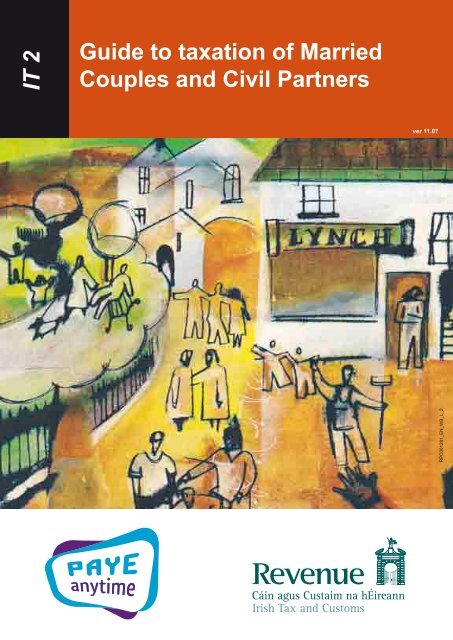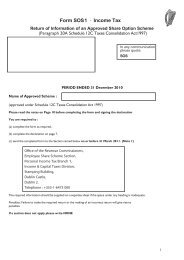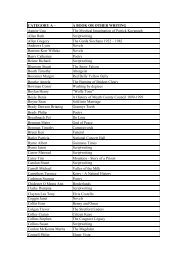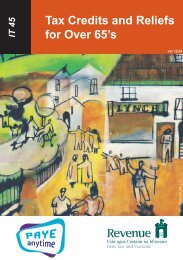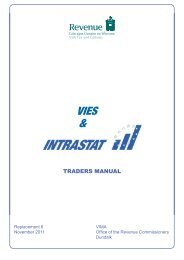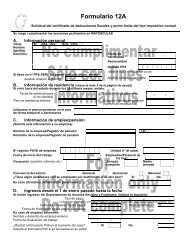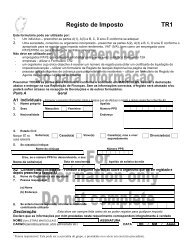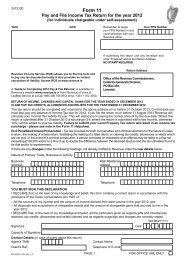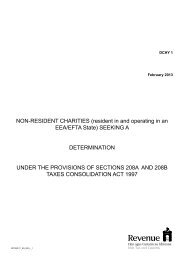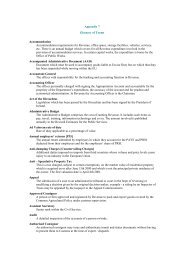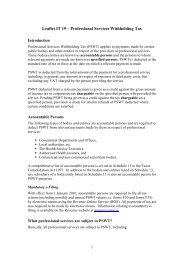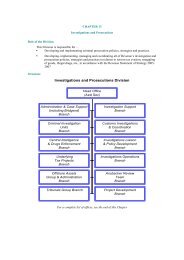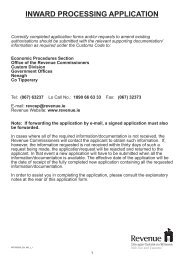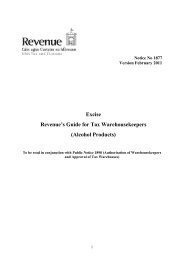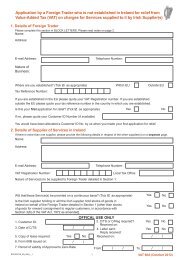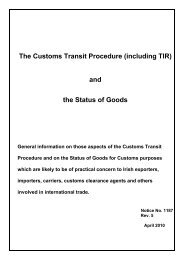IT2 - Guide to taxation of Married Couples and Civil Partners
IT2 - Guide to taxation of Married Couples and Civil Partners
IT2 - Guide to taxation of Married Couples and Civil Partners
Create successful ePaper yourself
Turn your PDF publications into a flip-book with our unique Google optimized e-Paper software.
IT 2<br />
<strong>Guide</strong> <strong>to</strong> <strong>taxation</strong> <strong>of</strong> <strong>Married</strong><br />
<strong>Couples</strong> <strong>and</strong> <strong>Civil</strong> <strong>Partners</strong><br />
ver 11.07<br />
RPC001281_EN_WB_L_2
Introduction<br />
This leaflet explains the tax treatment <strong>of</strong> married persons or civil partners in the year <strong>of</strong> marriage or in<br />
the year <strong>of</strong> registration <strong>of</strong> a civil partnership <strong>and</strong> in subsequent years.<br />
Year <strong>of</strong> Marriage or <strong>Civil</strong> <strong>Partners</strong>hip Registration<br />
Once married or registered in a civil partnership, you should advise your local Revenue <strong>of</strong>fice <strong>of</strong> the<br />
date <strong>of</strong> your marriage or civil partnership registration <strong>and</strong> quote your own <strong>and</strong> your spouse’s or civil<br />
partner’s Personal Public Service (PPS) numbers.<br />
For tax purposes, both parties continue <strong>to</strong> be treated as two single persons in the year <strong>of</strong> the<br />
marriage or the year the civil partnership was registered. However, if the tax you pay as two single<br />
persons in that year is greater than the tax which would be payable if you had been taxed as a couple<br />
in a marriage or civil partnership, a refund <strong>of</strong> the difference can be claimed. Any refund due is only<br />
from the date <strong>of</strong> marriage or registration <strong>of</strong> civil partnership <strong>and</strong> will be calculated at the end <strong>of</strong> that<br />
tax year.<br />
A refund <strong>of</strong> tax for the year <strong>of</strong> marriage or registration <strong>of</strong> civil partnership would normally only arise<br />
where a couple are taxed at different tax rates <strong>and</strong> one spouse or civil partner could benefit from<br />
the unused st<strong>and</strong>ard rate b<strong>and</strong> or from some <strong>of</strong> the unused tax credits <strong>of</strong> the other spouse or civil<br />
partner. See example on page 7.<br />
Subsequent Years<br />
The following options are available:<br />
• Joint Assessment<br />
• Separate Assessment<br />
• Separate Treatment (Assessed as Single Individuals).<br />
You may choose the method <strong>of</strong> <strong>taxation</strong> which is best suited <strong>to</strong> your circumstances. To help you<br />
decide, each method is described in detail in the following paragraphs.<br />
Joint Assessment<br />
What is Joint Assessment?<br />
Joint Assessment is usually the most favourable basis <strong>of</strong> assessment for couples in a marriage or<br />
civil partnership. It is au<strong>to</strong>matically given by your local Revenue <strong>of</strong>fice once you have advised them <strong>of</strong><br />
your marriage or civil partnership registration, but this doesn’t prevent you from electing for either <strong>of</strong><br />
the other options.<br />
Under Joint Assessment, the tax credits <strong>and</strong> st<strong>and</strong>ard rate b<strong>and</strong> can be allocated between spouses<br />
or civil partners <strong>to</strong> suit their circumstances. For example:<br />
• If only one spouse or civil partner has taxable income, all tax credits <strong>and</strong> the st<strong>and</strong>ard rate<br />
b<strong>and</strong> will be given <strong>to</strong> that individual<br />
• If both spouses or civil partners have taxable income, they can decide which spouse or civil<br />
partner <strong>of</strong> them is <strong>to</strong> be the assessable spouse or nominated civil partner <strong>and</strong> request their<br />
local Revenue <strong>of</strong>fice <strong>to</strong> allocate the tax credits <strong>and</strong> st<strong>and</strong>ard rate b<strong>and</strong> between them in<br />
whatever way they wish. (PAYE tax credit, employment expenses <strong>and</strong> the basic st<strong>and</strong>ard rate<br />
b<strong>and</strong> <strong>of</strong> €23,800 are non transferable.)<br />
Where the Revenue <strong>of</strong>fice does not receive a request for the allocation <strong>of</strong> tax credits <strong>and</strong> reliefs in a<br />
particular way, it will normally give all the tax credits (other than the other spouse’s or civil partner’s<br />
PAYE <strong>and</strong> expense tax credits) <strong>to</strong> the assessable spouse or nominated civil partner. See paragraph<br />
on st<strong>and</strong>ard rate b<strong>and</strong> on page 5 for information.<br />
2
The assessable spouse or nominated civil partner must complete the return <strong>of</strong> income for the couple<br />
<strong>and</strong> is chargeable <strong>to</strong> tax on the joint income <strong>of</strong> the couple.<br />
Allocating tax credits <strong>and</strong> st<strong>and</strong>ard rate b<strong>and</strong> via the Internet<br />
<strong>Couples</strong> taxed under Joint Assessment can specify how they wish their tax credits <strong>and</strong> st<strong>and</strong>ard rate<br />
b<strong>and</strong> <strong>to</strong> be allocated between them via the Internet using our PAYE Anytime service. This means you<br />
do not have <strong>to</strong> contact Revenue <strong>to</strong> have changes made. Once you confirm the changes you want<br />
made, a new tax credit certificate will issue within a few days with the amended details included.<br />
PAYE Anytime also allows you <strong>to</strong> claim a range <strong>of</strong> reliefs including Rent Relief, Home Carer’s Tax<br />
Credit, Health Expenses <strong>and</strong> many others as well as the facility <strong>to</strong> claim refunds for the previous 4<br />
years. For further information on PAYE Anytime, including the full range <strong>of</strong> reliefs available, please<br />
visit www.revenue.ie.<br />
How do we nominate the Assessable Spouse or Nominated <strong>Civil</strong> Partner?<br />
The couple themselves elect which <strong>of</strong> them is <strong>to</strong> be the assessable spouse or nominated civil partner.<br />
A verbal nomination made by either spouse or civil partner is acceptable. (Use the Assessable<br />
Spouse or Nominated <strong>Civil</strong> Partner Election Form <strong>to</strong> enable the nomination <strong>to</strong> be made.) While the<br />
nomination must be made <strong>to</strong> your local Revenue <strong>of</strong>fice on or before the 31st March in the tax year, it<br />
should ideally be made before the commencement <strong>of</strong> the tax year i.e. 1st <strong>of</strong> January, <strong>to</strong> ensure that<br />
the correct tax credits <strong>and</strong> st<strong>and</strong>ard rate b<strong>and</strong> are allocated <strong>to</strong> each spouse or civil partner from the<br />
commencement <strong>of</strong> the tax year.<br />
What is the position if we do not nominate the Assessable Spouse or Nominated<br />
<strong>Civil</strong> Partner?<br />
In the absence <strong>of</strong> a nomination, the assessable spouse or nominated civil partner is the spouse<br />
or civil partner with the highest income in the latest year for which details <strong>of</strong> both spouses’ or civil<br />
partners’ income are known. A spouse or civil partner will continue <strong>to</strong> be the assessable spouse or<br />
nominated civil partner unless the couple jointly elect that the other spouse or civil partner is <strong>to</strong> be<br />
the assessable spouse or nominated civil partner or until either spouse or civil partner opts for either<br />
Separate Assessment or Separate Treatment.<br />
Repayments<br />
Repayments arising from an end <strong>of</strong> year review will, in general, be apportioned <strong>and</strong> repaid on the<br />
basis <strong>of</strong> the tax paid by each spouse or civil partner.<br />
If one spouse or civil partner is Self-Employed can Joint Assessment apply?<br />
Yes. The flexibility that Joint Assessment affords can be very convenient where one spouse or civil<br />
partner pays tax under PAYE <strong>and</strong> the other pays tax under the Self Assessment system. You can let<br />
your circumstances dictate whether most <strong>of</strong> the tax should be paid under PAYE or in a lump sum on<br />
assessment. This will be determined by the manner in which the tax credits are allocated. If you wish<br />
<strong>to</strong> pay most <strong>of</strong> your tax under PAYE, the tax credits, other than the PAYE tax credit <strong>and</strong> employment<br />
expenses, should be <strong>of</strong>fset against the self assessment income.<br />
Can Joint Assessment apply if only one spouse or civil partner has taxable<br />
income?<br />
Yes. Joint Assessment is the only practical option in this situation. All tax credits, reliefs <strong>and</strong> the<br />
st<strong>and</strong>ard rate b<strong>and</strong> are allocated <strong>to</strong> the spouse or civil partner with the taxable income.<br />
Return <strong>of</strong> Income Form<br />
Only one form need be completed. This must be completed by the assessable spouse or nominated<br />
civil partner, showing both spouses’ or civil partners’ income <strong>and</strong> claiming full tax credits <strong>and</strong> reliefs.<br />
3
Are Tax Credit Certificates issued <strong>to</strong> each individual?<br />
Yes. If both spouses or civil partners are in employment, a tax credit certificate is issued <strong>to</strong> each<br />
spouse or each civil partner. All <strong>of</strong> the tax credits <strong>and</strong> reliefs due <strong>to</strong> a couple in a marriage or<br />
civil partnership, where Joint Assessment applies, are shown on both spouses’ or civil partners’<br />
certificates. Both certificates state the amount <strong>of</strong> tax credits <strong>and</strong> st<strong>and</strong>ard rate b<strong>and</strong> allocated <strong>to</strong> each<br />
spouse or civil partner. Where either spouse or civil partner has multiple sources <strong>of</strong> PAYE income, the<br />
amount <strong>of</strong> tax credits <strong>and</strong> st<strong>and</strong>ard rate b<strong>and</strong> allocated <strong>to</strong> each employment or pension is also shown<br />
on the certificate.<br />
Separate Assessment<br />
What is Separate Assessment?<br />
Under Separate Assessment your tax affairs are independent <strong>of</strong> those <strong>of</strong> your spouse or civil partner.<br />
The following tax credits are divided equally between you:<br />
– <strong>Married</strong> or <strong>Civil</strong> Partner’s Personal Tax Credit<br />
– Age Tax Credit<br />
– Blind Person’s Tax Credit<br />
– Incapacitated Child Tax Credit.<br />
The balance <strong>of</strong> the tax credits are given <strong>to</strong> each <strong>of</strong> you in proportion <strong>to</strong> the cost borne by you. The<br />
PAYE tax credit <strong>and</strong> employment expenses, if any, are allocated <strong>to</strong> the appropriate spouse or civil<br />
partner. Any tax credits, etc., other than the PAYE tax credit <strong>and</strong> employment expenses, which are<br />
unused by one spouse or civil partner may be claimed by the other spouse or civil partner. The tax<br />
credits may not generally be adjusted until after the end <strong>of</strong> the tax year.<br />
What happens under Separate Assessment <strong>to</strong> tax credits not fully used by one<br />
spouse or civil partner?<br />
Any unused tax credits (other than the PAYE tax credit <strong>and</strong> employment expenses) <strong>and</strong> st<strong>and</strong>ard<br />
rate b<strong>and</strong> up <strong>to</strong> €41,800 can be transferred <strong>to</strong> the other spouse or civil partner, but only at the end<br />
<strong>of</strong> the tax year. The increase in the st<strong>and</strong>ard rate b<strong>and</strong> <strong>of</strong> up <strong>to</strong> €23,800 is not transferable between<br />
spouses or civil partners. If you think you have unused tax credits or st<strong>and</strong>ard rate b<strong>and</strong>, you should<br />
contact your local Revenue <strong>of</strong>fice for a review after the end <strong>of</strong> the tax year. It is important <strong>to</strong> note that,<br />
overall, the amount <strong>of</strong> the tax payable under Separate Assessment is the same as that payable under<br />
Joint Assessment. See example on page 8.<br />
How do I claim Separate Assessment?<br />
Separate Assessment can be claimed either verbally or in writing. The claim can be made by either<br />
spouse or civil partner, <strong>and</strong> must be made in the six months between the 1st <strong>of</strong> Oc<strong>to</strong>ber <strong>of</strong> the<br />
preceding year <strong>and</strong> the 31st March in the year <strong>of</strong> the claim. It cannot be backdated <strong>to</strong> a previous year<br />
<strong>and</strong> it lasts until withdrawn. Whichever spouse or civil partner initially makes the claim must also be<br />
the one <strong>to</strong> withdraw it.<br />
What about Return <strong>of</strong> Income Forms?<br />
Each spouse or civil partner may complete a separate return <strong>of</strong> their own income. However, their<br />
local Revenue <strong>of</strong>fice will accept one joint return (which can be made by either spouse or civil partner)<br />
if it includes the income <strong>of</strong> both spouses or civil partners.<br />
4
Separate Treatment (Assessed as a Single Individual)<br />
What is Separate Treatment?<br />
Under Separate Treatment each spouse or civil partner is treated as a single person for tax purposes.<br />
Separate Treatment should not be confused with Separate Assessment.<br />
Both spouses or civil partners:<br />
• Are taxed on their own income<br />
• Receive tax credits <strong>and</strong> the st<strong>and</strong>ard rate b<strong>and</strong> due <strong>to</strong> a single person<br />
• Pay their own tax<br />
• Complete their own Return <strong>of</strong> Income form <strong>and</strong> claim their own tax credits.<br />
One spouse or civil partner cannot claim relief for payments made by the other <strong>and</strong> there is no right<br />
<strong>to</strong> transfer tax credits or st<strong>and</strong>ard rate b<strong>and</strong> <strong>to</strong> each other.<br />
How do I claim Separate Treatment?<br />
Separate Treatment can be claimed either verbally or in writing.<br />
Either spouse or civil partner can make the claim <strong>and</strong> the election lasts until withdrawn by the spouse<br />
or civil partner who claimed it. A claim for Separate Treatment, if required, must be made within the<br />
tax year (preferably at the beginning).<br />
This basis <strong>of</strong> assessment can be unfavourable in some circumstances because any unused tax<br />
credits or st<strong>and</strong>ard rate b<strong>and</strong> cannot be transferred. Home Carer’s Tax Credit cannot be claimed in<br />
respect <strong>of</strong> a spouse or civil partner who cares for a dependent person <strong>and</strong> who may otherwise qualify<br />
for the relief. See example <strong>of</strong> Separate Treatment on page 9.<br />
Other Relevant Matters<br />
St<strong>and</strong>ard Rate B<strong>and</strong><br />
The st<strong>and</strong>ard rate b<strong>and</strong> for couples in a marriage or civil partnership for 2011 is €41,800 subject<br />
<strong>to</strong> an increase <strong>of</strong> up <strong>to</strong> €23,800 where both spouses or civil partners are working. The increase is<br />
limited <strong>to</strong> the lower <strong>of</strong> €23,800 or the amount <strong>of</strong> the income <strong>of</strong> the spouse or civil partner with the<br />
smaller income. This increase is not transferable between spouses or civil partners. The increase in<br />
the st<strong>and</strong>ard rate b<strong>and</strong> is not allowable where a couple are claiming the Home Carer’s Tax Credit.<br />
However, if the increased st<strong>and</strong>ard rate b<strong>and</strong> is more beneficial, you can claim the increased<br />
st<strong>and</strong>ard rate b<strong>and</strong> instead <strong>of</strong> the Home Carer’s Tax Credit. In practice your local Revenue <strong>of</strong>fice<br />
will grant you whichever is the more beneficial. Leaflet IT 66 ‘Home Carer’s Tax Credit’ gives further<br />
information <strong>and</strong> examples <strong>to</strong> help you calculate which is the most beneficial.<br />
It is very important that you have the correct tax credits <strong>and</strong> st<strong>and</strong>ard rate b<strong>and</strong> as otherwise you will<br />
not pay the correct amount <strong>of</strong> tax.<br />
Example:<br />
You are the assessable spouse or nominated civil partner <strong>and</strong> you earn €46,000 in 2011. Your<br />
spouse or civil partner has a Social Welfare pension <strong>of</strong> €8,500. The income is taxable as follows:<br />
Self €41,800 @ 20%<br />
€4,200 @ 41%<br />
Spouse or <strong>Civil</strong> Partner €8,500 @ 20%<br />
5
I am married or registered in a civil partnership <strong>and</strong> ceased employment some<br />
years ago. I am about <strong>to</strong> start a temporary job. What is my tax position?<br />
The usual provisions on commencing employment will apply. As you won’t hold a current Form P45,<br />
you should contact your local Revenue <strong>of</strong>fice immediately so that the amount <strong>of</strong> your tax credits <strong>and</strong><br />
st<strong>and</strong>ard rate b<strong>and</strong> can be ascertained <strong>and</strong> advised <strong>to</strong> your employer. This will enable your employer<br />
<strong>to</strong> deduct the correct amount <strong>of</strong> tax. You should also give your employer your PPS number.<br />
Your spouse or civil partner is probably using all the tax credits <strong>and</strong> st<strong>and</strong>ard rate b<strong>and</strong> due <strong>to</strong> you as<br />
a couple in a marriage or civil partnership. If your employment is temporary it may not be worthwhile<br />
disturbing the tax credits for that year. You are entitled <strong>to</strong> a PAYE tax credit, expenses (if due in<br />
respect <strong>of</strong> your employment) <strong>and</strong> st<strong>and</strong>ard rate b<strong>and</strong> in your own right provided you qualify for them.<br />
If your estimated income for the tax year is €23,800 or less you will pay tax at the st<strong>and</strong>ard rate (20%<br />
in 2011). If your income for the tax year will exceed €23,800 your tax rate will depend on the level <strong>of</strong><br />
your joint income (both spouses or civil partners). See paragraph headed St<strong>and</strong>ard Rate B<strong>and</strong>. If you<br />
are in any doubt, contact your local Revenue <strong>of</strong>fice <strong>to</strong> ensure you have the correct tax credits <strong>and</strong><br />
st<strong>and</strong>ard rate b<strong>and</strong>.<br />
If your spouse or civil partner is not in receipt <strong>of</strong> taxable income you can claim all tax credits<br />
<strong>and</strong> the st<strong>and</strong>ard rate b<strong>and</strong>. Remember however, that in general, Jobseekers Benefit (formerly<br />
Unemployment Benefit) <strong>and</strong> Illness Benefit (formerly Disability Benefit) are taxable sources <strong>of</strong><br />
income. (Additional information is available in Leaflets <strong>IT2</strong>2 <strong>and</strong> <strong>IT2</strong>4.)<br />
If you are a Home Carer you can have income up <strong>to</strong> €5,080 without affecting the Home Carer’s Tax<br />
Credit. This tax credit is reduced where the income is over €5,080. Full details are available in Leaflet<br />
IT66 ‘Home Carer’s Tax Credit’. In certain circumstances the increased st<strong>and</strong>ard rate b<strong>and</strong> may be<br />
more beneficial.<br />
Is the position the same if I commence permanent employment?<br />
Yes. If you decide you want the tax credits spread more evenly over the following year, you should<br />
notify your local Revenue <strong>of</strong>fice in time before the beginning <strong>of</strong> the new tax year on the 1st <strong>of</strong><br />
January.<br />
If I cease my employment can I claim a refund <strong>of</strong> tax?<br />
Yes, provided you have paid tax, the employment ceased before the end <strong>of</strong> the tax year, <strong>and</strong> any tax<br />
payable on a payment from the Department <strong>of</strong> Social Protection is less than your tax credits. If you<br />
are receiving some or all <strong>of</strong> the tax credits due on Joint Assessment <strong>and</strong> you cease employment, you<br />
can transfer unused tax credits <strong>to</strong> your spouse or civil partner instead <strong>of</strong> claiming a tax refund.<br />
Note that your own PAYE tax credit <strong>and</strong> employment expenses or the increase in the st<strong>and</strong>ard rate<br />
b<strong>and</strong> cannot be transferred.<br />
Do I have the same Revenue <strong>of</strong>fice as my spouse or civil partner?<br />
As a PAYE employee, your tax affairs are dealt with in the region where you live. However, if you<br />
are self-employed, your place <strong>of</strong> business dictates the region where your tax affairs are dealt with.<br />
Any Revenue correspondence that you receive will show the contact address <strong>of</strong> your local Revenue<br />
<strong>of</strong>fice or if you visit www.revenue.ie <strong>and</strong> enter your PPS number in<strong>to</strong> our Contact Loca<strong>to</strong>r, the name,<br />
address <strong>and</strong> contact details <strong>of</strong> your local Revenue <strong>of</strong>fice will be displayed.<br />
6
Tax Treatment in Year <strong>of</strong> Marriage or <strong>Civil</strong> <strong>Partners</strong>hip Registration<br />
Example:<br />
You <strong>and</strong> your spouse or civil partner entered a marriage or civil partnership on 10/7/2011. You earned<br />
€48,000 in 2011 <strong>and</strong> your spouse or civil partner earned €24,000.<br />
Tax payable by you <strong>and</strong> your spouse or civil partner as Single People:<br />
Self<br />
Spouse or <strong>Civil</strong> Partner<br />
€ €<br />
Income 48,000 24,000<br />
St<strong>and</strong>ard Rate B<strong>and</strong> 32,800 x 20% = 6,560 24,000 x 20% = 4,800<br />
15,200 x 41% = 6,232<br />
12,792<br />
Tax Credits<br />
Personal Tax Credit 1,650 1,650<br />
PAYE Tax Credit 1,650 1,650<br />
3,300 3,300 3,300 3,300<br />
Tax Payable 9,492 1,500<br />
Combined Tax Payable Self 9,492<br />
Spouse or <strong>Civil</strong> Partner 1,500<br />
10,992<br />
Tax payable by you <strong>and</strong> your spouse or civil partner under Joint Assessment as a Couple in a<br />
Marriage or <strong>Civil</strong> <strong>Partners</strong>hip would be:<br />
€<br />
Income Self 48,000<br />
Spouse or <strong>Civil</strong> Partner 24,000<br />
Total 72,000<br />
St<strong>and</strong>ard Rate B<strong>and</strong> €<br />
Self 41,800 x 20% = 8,360<br />
6,200 x 41% = 2,542<br />
Spouse or <strong>Civil</strong> Partner 23,800 x 20% = 4,760<br />
200 x 41% = 82<br />
15,744<br />
Tax Credits<br />
<strong>Married</strong> or <strong>Civil</strong> <strong>Partners</strong> Tax Credit 3,300<br />
PAYE Tax Credit x 2 3,300<br />
6,600 6,600<br />
Tax Payable 9,144<br />
The difference between the tax payable by you <strong>and</strong> your spouse or civil partner as single persons<br />
<strong>and</strong> the tax payable by you both as a couple in a marriage or civil partnership is €1,848 i.e. €10,992<br />
less €9,144. This amount <strong>of</strong> €1,848 is apportioned by the number <strong>of</strong> months for which you have been<br />
married or registered in a civil partnership in the tax year i.e. €1,848 x 6/12 = €924.<br />
You <strong>and</strong> your spouse or civil partner can claim a refund <strong>of</strong> this €924 after the end <strong>of</strong> the tax year. The<br />
refund is apportioned between you both in proportion <strong>to</strong> the tax payable by each <strong>of</strong> you as follows:<br />
The amount <strong>to</strong> be repaid <strong>to</strong> you is: €924 x €9,492 = €797.91<br />
€10,992<br />
The amount <strong>to</strong> be repaid <strong>to</strong> your spouse or civil partner is: €924 x €1,500 = €126.09<br />
€10,992<br />
7
Similarities <strong>and</strong> differences between Joint Assessment, Separate Assessment or<br />
Separate Treatment<br />
In the following examples the tax liability <strong>of</strong> you <strong>and</strong> your spouse or civil partner is shown under each<br />
option. The same figures are used in each example. You earned €48,000 in 2011 <strong>and</strong> your spouse or<br />
civil partner earned €25,000.<br />
Joint Assessment<br />
€<br />
Income Self 48,000<br />
Spouse or <strong>Civil</strong> Partner 25,000<br />
Total 73,000<br />
St<strong>and</strong>ard Rate B<strong>and</strong> Self 41,800 x 20% = 8,360<br />
6,200 x 41% = 2,542<br />
Spouse or <strong>Civil</strong> Partner 23,800 x 20% = 4,760<br />
1,200 x 41% = 492<br />
16,154<br />
Tax Credits<br />
<strong>Married</strong> or <strong>Civil</strong> <strong>Partners</strong> Tax Credit 3,300<br />
PAYE Tax Credit x 2 3,300<br />
6,600 6,600<br />
Tax Payable 9,554<br />
Separate Assessment<br />
Self<br />
Spouse or <strong>Civil</strong> Partner<br />
€ €<br />
Income 48,000 25,000<br />
St<strong>and</strong>ard Rate B<strong>and</strong> 32,800 x 20% = 6,560 25,000 x 20% = 5,000<br />
Transferred from Spouse or <strong>Civil</strong> Partner 7,800 x 20% = 1,560<br />
7,400 x 41% = 3,034<br />
11,154 5,000<br />
Tax Credits<br />
Personal Tax Credit 1,650 1,650<br />
PAYE Tax Credit 1,650 1,650<br />
3,300 3,300 3,300 3,300<br />
7,854 1,700<br />
Total Tax Payable 9,554<br />
The transferable portion <strong>of</strong> the lower tax st<strong>and</strong>ard rate b<strong>and</strong> unused by your spouse or civil partner -<br />
€7,800 (i.e. €32,800 less €25,000) is transferred <strong>to</strong> you. Under both Joint Assessment <strong>and</strong> Separate<br />
Assessment, both spouses or civil partners pay the same amount <strong>of</strong> tax overall.<br />
8
Separate Treatment (Assessed as a Single Individual)<br />
Self<br />
Spouse or <strong>Civil</strong> Partner<br />
€ €<br />
Income 48,000 25,000<br />
St<strong>and</strong>ard Rate B<strong>and</strong> 32,800 x 20% = 6,560 25,000 x 20% = 5,000<br />
15,200 x 41% = 6,232<br />
12,792 5,000<br />
Tax Credits<br />
Personal Tax Credit 1,650 1,650<br />
PAYE Tax Credit 1,650 1,650<br />
3,300 3,300 3,300 3,300<br />
9,492 1,700<br />
Total Tax Payable 11,192<br />
The tax liability is greater under Separate Treatment than under Joint Assessment <strong>and</strong> Separate<br />
Assessment due <strong>to</strong> the nontransfer <strong>of</strong> your spouse’s or civil partner’s unused st<strong>and</strong>ard rate b<strong>and</strong>.<br />
9
Further Information<br />
This leaflet is for general information only. For further information you can visit www.revenue.ie or<br />
contact your Regional PAYE LoCall Service whose number is listed below (within the Republic <strong>of</strong><br />
Irel<strong>and</strong> only)<br />
• Border Midl<strong>and</strong>s West Region 1890 777 425<br />
Cavan, Donegal, Galway, Leitrim, Longford,<br />
Louth, Mayo, Monaghan, Offaly, Roscommon,<br />
Sligo, Westmeath<br />
• East & South East Region 1890 444 425<br />
Carlow, Kildare, Kilkenny, Laois, Meath,<br />
Tipperary, Waterford, Wexford, Wicklow<br />
• Dublin Region 1890 333 425<br />
Dublin (City <strong>and</strong> County)<br />
• South West Region 1890 222 425<br />
Clare, Cork, Kerry, Limerick<br />
Please note that the rates charged for the use <strong>of</strong> 1890 (LoCall) numbers may vary among different<br />
service providers.<br />
If calling from outside the Republic <strong>of</strong> Irel<strong>and</strong>, please telephone + 353 1 702 3011<br />
4-year time limit: A claim for tax relief must be made within 4 years after the end <strong>of</strong> the tax year <strong>to</strong><br />
which the claim relates.<br />
Accessibility: If you are a person with a disability <strong>and</strong> require this leaflet in an alternative format the<br />
Revenue Access Officer can be contacted at access<strong>of</strong>ficer@revenue.ie<br />
This leaflet is intended <strong>to</strong> describe the subject in general terms. As such, it does not attempt <strong>to</strong> cover<br />
every issue which may arise in relation <strong>to</strong> the subject. It does not purport <strong>to</strong> be a legal interpretation<br />
<strong>of</strong> the statu<strong>to</strong>ry provisions <strong>and</strong> consequently, responsibility cannot be accepted for any liability<br />
incurred or loss suffered as a result <strong>of</strong> relying on any matter published herein.<br />
Revenue Commissioners<br />
July 2011<br />
10


